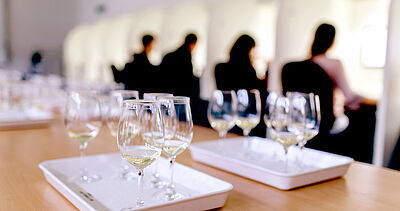Sensory and material characterization
of climate-induced off-notes in white wine and minimization of sunburn damage in grapes
through the use of clays and shading
Background to the project
Climate change is one of the greatest challenges facing the wine industry today. Global warming can have both positive and negative effects on viticulture. Rising temperatures accelerate vine development, which has led to grapes ripening up to four weeks earlier in the last decade than thirty years ago. While rising temperatures improve the growing conditions for international grape varieties (Chardonnay, Merlot, Cabernet Franc, Syrah, etc.) in Germany, negative effects can also be observed for indigenous varieties that have been selected over decades due to their adaptation to a cooler climate. One example of this is Riesling, which is the most widely planted grape variety in Germany with a cultivation area of 23,800 hectares (2017) and thus accounts for 37% of global cultivation. With increasing temperature and sun exposure, an aroma defect known as a "petrol note" has increasingly appeared in German Rieslings in recent years, which was previously only limited to Australian and South African Rieslings. As part of an earlier project, it was shown that radiation-induced forced carotenoid degradation in the grape produces reactive carotenoid metabolites which, at the low pH values present in Riesling, are acid-catalyzed to 1,1,6-trimethyl-1,2-dihydronaphthalene (TDN), which has a "petrol-like" odor. While the climate-induced "petrol note" is primarily limited to Riesling, "sunburn damage" in grapes is a phenomenon that has been occurring increasingly since the 1990s and affects both white and red wine grapes. In the worst case, radiation-induced damage to the epidermis can lead to water leakage and the shriveling or premature wilting of the berries, which is associated with considerable yield losses and financial losses for winegrowers. Radiation-induced damage can vary in severity, but even when less severe, sensory deviations can occur that affect both the smell (appearance of "dull" odor notes that mask the varietal aroma) and the taste (appearance of bitter and astringent notes). The causes of these changes are still only partially understood at the molecular level and there has been a lack of practical research into measures that could curb this sensory damage.
Aim of the research project
Against this background, the aim of the research project is to investigate the material causes of the sensory off-notes in white wine that are triggered by changes in climatic conditions, in particular the occurrence of sunburn damage to grapes. At the same time, a viticultural minimization strategy is to be developed to reduce sunburn damage.
The project has been running since 2020 and is currently in its final phase. Caterina Szmania from Recklinghausen is one of the researching doctoral students in this project in Ulrich Fischer's working group and is carrying out the sensory and aroma-chemical analyses. She studied food chemistry in Braunschweig under Peter Winterhalter and completed her second state examination at the LANUV in North Rhine-Westphalia. After working in quality management for food companies, she looked for a new challenge and decided to go into research.
Research centers and contact persons
Rural Area Service Center (DLR) Rhenish Palatinate: Ulrich Fischer, Jochen Bogs, Jochen Vestner, Caterina Szmania, Jonas Waber
TU Braunschweig: Peter Winterhalter, Sebastian Scharf, Philipp Hopfstock
contact

Dr. Jochen Vestner

Jonas Waber

